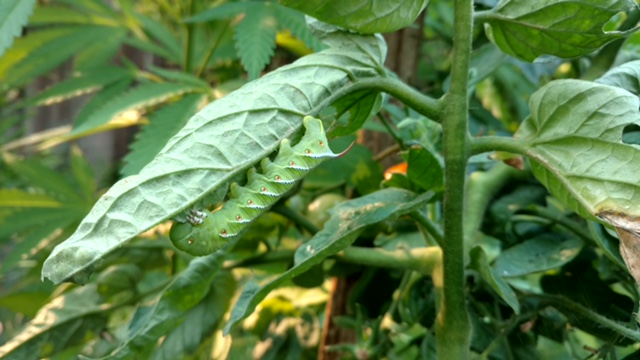
August heat brings out spike in population of these giant caterpillars

|
|
The tomato hornworm's coloring makes it hard to see among tomato leaves. Look
for its poop on leaves below or, at night, search using a UV flashlight. (Photo: Debbie Arrington)
|
They look like something out of a sci-fi movie – if you can spot them. And what they do to tomato plants is absolutely horrifying.
Recent hot, dry weather brought out a late-summer surge of one of the biggest bugs in our vegetable gardens: The tomato hornworm.
They love these last days of summer – and munching away on ripe tomatoes. While many critters retreat in high heat, these invaders actually spike in numbers and activity as the mercury rises.
Natural enemies usually keep their populations under control. But hornworm numbers tend to go up in August along with the temperature.
I saw this firsthand in my own Sacramento garden. I've picked off five hornworms from my tomato vines in five days.
Fat as a finger and just as long, hornworms rank as Sacramento’s largest caterpillars. They eat big bites out of their favorite food: Juicy tomatoes. They’ll also eat hard green tomatoes, leaves and stems.
Their stripes let them hide in plain sight. They blend in so well with their surroundings, they can seem impossible to spot.
What’s easy to see are leaves that have been stripped bare to the stem and damaged tomatoes. Other pests and critters may take bites out of tomatoes, but those stripped leaves – especially if the damage seems to appear overnight – usually indicate hornworms.
If you suspect hornworms, look for their poop. They leave large black or green droppings on or around the plant. If you see those droppings, carefully inspect the plant’s nearby leaves and stems. When you find it, pick off the hornworm and dispose of it. (Folks who raise chickens say their hens love them as a snack.)
If the hornworm escapes capture, it burrows into the soil and pupates into a moth of equally gigantic proportion: The hawk moth. Emerging in spring, this brown and gray moth has a 5-inch wingspan.
Rototilling the tomato bed after harvest prevents those moths from ever developing – and laying eggs next spring.
For more on tomato hornworms: http://ipm.ucanr.edu/PMG/GARDEN/VEGES/PESTS/hornworm.html
Comments
0 comments have been posted.Sacramento Digs Gardening to your inbox.
Sites We Like
Garden Checklist for week of April 21
This week there’s plenty to keep gardeners busy. With no rain in the immediate forecast, remember to irrigate any new transplants.
* Weed, weed, weed! Get them before they flower and go to seed.
* April is the last chance to plant citrus trees such as dwarf orange, lemon and kumquat. These trees also look good in landscaping and provide fresh fruit in winter.
* Smell orange blossoms? Feed citrus trees with a low dose of balanced fertilizer (such as 10-10-10) during bloom to help set fruit. Keep an eye out for ants.
* Apply slow-release fertilizer to the lawn.
* Thoroughly clean debris from the bottom of outdoor ponds or fountains.
* Spring brings a flush of rapid growth, and that means your garden is really hungry. Feed shrubs and trees with a slow-release fertilizer. Or mulch with a 1-inch layer of compost.
* Azaleas and camellias looking a little yellow? If leaves are turning yellow between the veins, give them a boost with chelated iron.
* Trim dead flowers but not leaves from spring-flowering bulbs such as daffodils and tulips. Those leaves gather energy to create next year's flowers. Also, give the bulbs a fertilizer boost after bloom.
* Pinch chrysanthemums back to 12 inches for fall flowers. Cut old stems to the ground.
* Mulch around plants to conserve moisture and control weeds.
* From seed, plant beans, beets, cantaloupes, carrots, corn, cucumbers, melons, radishes and squash.
* Plant onion sets.
* In the flower garden, plant seeds for asters, cosmos, celosia, marigolds, salvia, sunflowers and zinnias.
* Transplant petunias, zinnias, geraniums and other summer bloomers.
* Plant perennials and dahlia tubers for summer bloom.
* Mid to late April is about the last chance to plant summer bulbs, such as gladiolus and tuberous begonias.
* Transplant lettuce seedlings. Choose varieties that mature quickly such as loose leaf.